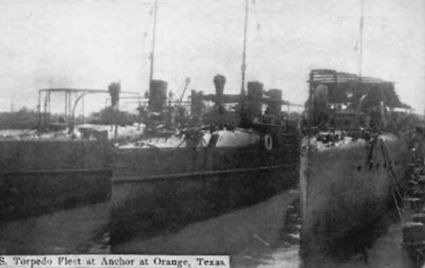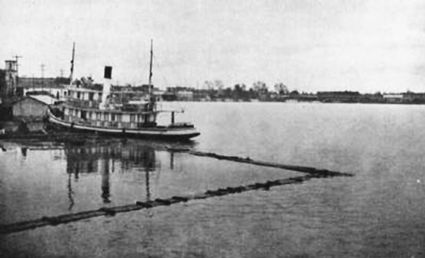Fresh Water. Deep Water. Safe Harbor. Port of Orange.
Last updated 12/24/2009 at Noon
by Nina Harden The year that the Orange Port became a deep-water port leading citizens proudly contributed to the publication of the history of the district and the industries that backed it.
One of the writers noted, "Located on the broad waters of the matchless Sabine River, 12 miles above the stream's outlet to Sabine Lake and the Sabine-Neches Canal, Orange is the Gate City of Texas, the river forming the boundary between the Lone Star State and Louisiana, and is 'Nature's outlet to the Sea' for the vast territory of Southeast Texas and Southwest Louisiana." Noting that the "Sabine River gives her one of the best land-locked, fresh water harbors to be found in North America and without a peer on the coast of the Gulf of Mexico." The writer emphasized the safe anchorage of ships "in the broad turning basin opposite the city and reaches of the river from the basin to the site of the city slips." Something peculiar to the waters of the Sabine was said to remove barnacles and the insects that infest the waters of salt harbors and the deep, causing them to "drop from the hulls of the vessels as though removed by a chemical bath!" The account then continued, "Anchorage of even brief duration in the fresh waters of the harbor of Orange is worth dollars to any vessel, as it will defer by weeks by even months, the necessity of a haul-out for cleaning and painting.
The water of the Sabine River is famed for its absolute freedom from the matter that forms scale in boilers.
It has long been recognized by steamboat owners and operators of railroads and industrial plants as unexcelled for steam purposes.
Boilers are in use in the city of Orange that have been constantly in service for the upwards of 35 years without corrosion, and no water has ever been used in them but that of the Sabine River.
The use of the water, which can be had in unbounded quantities without cost, by vessels visiting the harbor, in the washing of boilers and in providing supplies for the voyage, will alone prove a saving that will appeal to owners of steam vessels.
There is no finer drinking water to be had than flows from the central plant supplying the city mains having three large wells; that yield some 2,000 gallons of water per minute to the reservoirs.
There are private flowing wells in various parts of the city also and this unbounded supply of artesian water, declared chemically absolutely pure by state chemists, is one of the city's greatest assets.
Vessels can take their supplies of this splendid water at rates that will be set at an absolute minimum.
Sailing vessels and steamships alike must have water for drinking and cooking purposes, and the absolute assurance that Orange is able to offer of water in plenty to fill the tanks of the largest vessels that will navigate these waters, water that bears the seal of approval of the many chemists who have analyzed it from time to time, will alone compensate the ship captain and his crew for the 30 mile trip by canal and river from the bar to Orange.
The writer then pointed out that vessels coming to Orange were handled by the Sabine Pass pilots, "the same association of pilots handling everything that is bound in or out of Sabine Pass, Port Arthur or Beaumont." Several of the pilots are thoroughly acquainted with the Sabine River channel.
Spar buoys mark the channel through the Sabine River to the Port of Orange and beacons have been installed under the direction of the board of engineers by the lighthouse department making navigation of the river safe by day and by night.
Development of the deep water port began with the deeding of a tract of land by W.H. Stark and E.W. Brown for the purpose.
The lower side of the slip was to be occupied by wharves and warehouses, to be municipally owned and controlled.
Contemplated plans included the building of a primary unit of a warehouse 500 feet in length and an open dock of equal length, extending back from the mouth of the slip to occupy a third of the length.
Plans called for the use of the most modern and economical of devices for loading and unloading cargo.
The wharves, which were to be served by the city owned railroad that would connect with all transportation lines entering the city.
The rail line was to be about a mile in length and was provided for in the ordinance passed for the construction of the slip and wharves and plans called for a road to be built to the wharves.
Property deeded to the city extended from the river front to a city street.
Lutcher and Moore Lumber Co. planned to build private wharves and loading facilities for the two large sawmills located at this point for shipping their products to foreign countries.
This lumber and timber would be delivered to ships' hatches from an electrically operated monorail system extending direct from the mills to the ship.
This equipment was planned to enable them to load several vessels at the same time as the monorail system to be installed specified a delivery capacity of 50,000 feet board measure of lumber daily.
The city was to have a police jurisdiction of the wharves and terminals under a state law that gave cities the authority to extend their limits for police purposes for a number of miles up and down a navigable stream.
The city has already incorporated this law into the municipal code for jurisdiction of ten miles above and ten miles below the city.
Earlier that year the voters of Orange county had passed a bond issue of $150,000 by a margin of ten to one to finance the construction of the slip, wharves and railroad.
Voters had also passed a bond issued of an equal amount to build schools and improve city streets.
















Reader Comments(0)